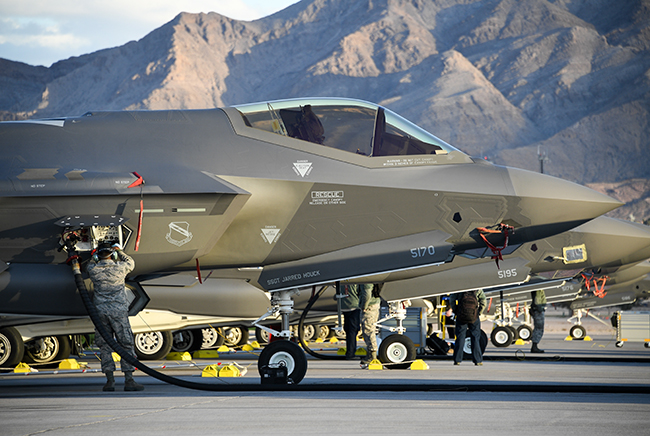
A crew chief with the 4th Aircraft Maintenance Unit fuels an F-35A during Red Flag 19-1, Nellis AFB, Nev., on Feb. 6, 2019. Air Force photo by R. Nial Bradshaw.
The continued sustainment problems plaguing both the F-35 program and broader military readiness are a major focus of the House Armed Services readiness subcommittee mark of the 2020 defense policy bill, which calls for limiting acquisition funding until the F-35’s issues are addressed.
The subcommittee’s mark, released June 4, would limit the funding for F-35 acquisition to 75 percent of the authorized amount until a report is submitted detailing the steps being made to improve the availability and accountability of F-35 parts. The Pentagon is requesting $11.2 billion for F-35 procurement in 2020, up from the authorized $7.6 billion in 2019.
A systemic lack of spare parts has been the driving force of low F-35 readiness, with the aircraft’s full mission capable rate across all services sitting at just 27 percent, the Government Accountability Office states in a recent report. Older parts are not compatible with newer jets, and a limited number of suppliers have been tasked with producing parts, according to GAO.
F-35 Joint Program Office Executive Vice Adm. Mat Winter told Air Force Magazine in December that parts are a “major contributor” to low availability of the fleet, and the office is seeking to increase spare parts production.
“While the F-35 brings advanced, fifth-generation aviation capabilities to our military, the program faces sustainment challenges in areas including repair capacity, global spare parts availability and capability, mission capability, and functionality of its Autonomic Logistics Information System,” the subcommittee’s mark states.
The high sustainment costs of the fleet were cited as a driving force for the Pentagon to move toward buying F-15EXs to augment the service’s fighter fleet.
In addition to the study on parts, the subcommittee’s version of the bill calls for the Comptroller General of the United States to study the status of the F-35’s sustainment strategy, the Pentagon’s oversight and prime contractor management of sustainment functions, and DOD’s ability to reduce costs of F-35 fleet sustainment. The comptroller also would review other issues it determines “of critical importance to the long-term viability” of the F-35 and present a report by March 1, 2020.
Additionally, the mark calls for the military services to develop a detailed plan for the “planning, programming, budgeting, and execution of funding that supports the sustainment of weapon systems and equipment.”
F-35 manufacturer Lockheed Martin announced on June 3, the company has delivered its 400th F-35 and the overall fleet has surpassed 200,000 flight hours.